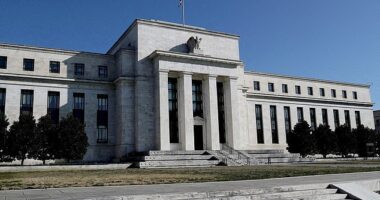UK HOUSE prices have soared over the past year, jumping 5.8% since last October, according to new data from Nationwide.
The building society found the average house price in the UK in October was £227,826, marking a five-year high, and an increase of 0.8% from the previous month.
September saw a similar increase month-on-month of 0.9%, following a 2% bump in August.
October’s increase means house prices are now on average £7,532 higher than they were at the same time last year.
The new numbers build on data from Nationwide’s index that showed house prices saw their biggest monthly rise in 16 years in August. Mortgage approvals have also reached their highest levels for 13 years.
Despite this jump, the market is likely to see a “sharp” downturn when the government’s stamp duty holiday ends, the mortgage provider warned.
A temporary stamp duty holiday, which launched in July and is available until March 31 next year, has helped boost the property market following the coronavirus lockdown.
The tax was temporarily scrapped in July on properties selling for up to £500,000.
It’s positive news for sellers who can cash in on buyers with bigger budgets but potential homeowners risk paying over the odds if the house price boom doesn’t last.
What is stamp duty?
STAMP duty land tax (SDLT) is a lump sum payment anyone buying a property or piece of land over a certain price has to pay.
Up until July 8, most house-buyers in England and Northern Ireland had to pay stamp duty on properties over £125,000.
This was temporarily increased to £500,000 until March 31, 2021 in the government’s mini-Budget in July 2020.
The rate a buyer has to fork out varies depending on the price and type of property.
Rates are different depending on whether it is residential, a second home or buy-to-let, or whether you’re a first-time buyer.
The usual system in England for residential properties means:
- First-time buyers pay nothing on properties below £300,000 (and relief available on properties of up to £500,000)
- You pay nothing if the property costs below £125,000
- You pay 2% if it is worth between £125,001 and £250,000
- You pay 5% if between £250,001 and up to £925,000
- You pay 10% if it is between £925,001 and £1.5million
- You pay 12% on anything over £1.5million
For second homes or buy to let properties:
- 3% on purchases up to 125,000
- 5% on purchases between £125,001 and £250,000
- 8% on purchases above £250,001 and £925,000
- 13% on purchases above £925,001 and £1.5 million
- 15% on purchases above £1.5 million
The UK economic recovery has lost some momentum over the past few months, as economic growth slowed sharply to 2.5% in August, down from 6.4% in July.
The house price boom also comes as the job market has weakened. Unemployment rose 4.5% in the three months to August.
Robert Gardner, Nationwide’s chief economist, said the housing market has “remained robust” with an increasing level of mortgage approvals.
Despite this the outlook is “highly uncertain” and will depend on how the coronavirus progresses, he said.
“Behavioural shifts as a result of Covid-19 may provide support for housing market activity, while the stamp duty holiday will continue to provide a near term boost by bringing purchases forward,” he continued.
Surveyors at Good Move also noted that as Job Support Schemes taper off and unemployment levels peak, price growth is likely to slow down.
Ross Counsell, chartered surveyor and director at Good Move, said: “We expect buyers will also be more cautious, and possibly less inclined to commit to buying a property.”
Counsell said that it’s likely lenders will begin to make a more cautious approach to mortgages, for example requiring larger deposits and secure employment.
The numbers back up recent data released by Rightmove that showed asking prices had risen 1.1% in October compared with September.
It also comes as the government considers a 5% deposit mortgages scheme, aiming to help create “generation buy”.
Looking to buy or sell a home? Check out our guide on what’s next for house prices.

















